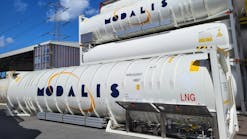As demand disappeared, so did space to hold the world’s oil
As the demand for gasoline dried up with stay-at-home orders in the United States due to the coronavirus pandemic—and Saudi Arabia and Russia flooded the market with product amid an oil price war—storage terminals at home and abroad continued to fill up with crude oil and refined product, leading to numerous warnings of waning capacity.
The most recent reports as Bulk Transporter went to press were downright dire.
Reuters said in mid-April that the occupancy rate in Cushing, Oklahoma, home to roughly 13% of the total US oil storage capacity, already had topped 70%, representing nearly 60 million barrels of crude oil, and most of the remaining capacity was spoken for. Cushing’s network of tank farms holds about 90 million barrels across 15 storage terminals.
Then the Nymex West Texas Intermediate (WTI) crude oil futures settled at a record low -$37.63/bbl on April 20, meaning traders were paying buyers to take oil that Cushing no longer could accept, underscoring the severity of the storage crisis.
“Overall, what all the analysts and market watchers were saying is that storage is going to be completely spoken for by early May,” said Kathryn Clay, president of the International Liquid Terminals Association, which represents liquid terminal and above-ground storage tank operators. “The ability of storage terminals to move product around can give you some leeway but it has limits, and that’s because some of the tanks are purpose-built for certain kinds of commodities.
“I was speaking to one of our terminal-member companies that doesn’t store crude oil as part of their business model, they store food products, and they’ve actually been approached and asked if they would be willing to switch out some of their food-based commodity, in their tanks that were designed for that, and make that storage available for crude oil. The challenge is, there are great dollar signs in the near term for doing that, but the consequence of that is once you’ve switched that tank to crude oil storage, it can only store crude oil for the rest of the life of that tank
“And so it’s a difficult situation in a business sense, and in this particular case, the operator decided not to do it, because they see this as a very drastic but ultimately short-term market condition, and they have to have the long view.”
In addition to approaching storage terminal operators about transforming storage, operators have looked for other, more creative means, including storing oil on off-shore vessels—which Clay said could cost as much as $150,000 per day, far more than typical above-ground liquid storage—pipelines, and even tank trailers.
To help alleviate the situation, the US negotiated with nine companies, reportedly including Chevron and ExxonMobil, to rent space in the US Strategic Petroleum Reserve to store 23 million barrels of crude oil, which Clay emphasized should only be a temporary measure since it amounts to subsidized storage for these companies.
“We take no issue with the Trump administration’s plans on utilizing the SPR, but we think it’s worth noting that this is only appropriate under very special circumstances,” Clay said.
Fortunately for producers, at least one industry expert sees an opening at the top of the tank.
Vincent DiCosimo, an executive with a major midstream who serves as a director with ILTA and the Texas Pipeline Association, points to several indicators, including an improving spread in the Brent Oil price index, and a slow-down of oil flowing into storage—based on his examinations of the latest American Petroleum Institute and Energy Information Agency inventories—he says show the demand for capacity no longer is as severe.
“There’s a lot more elasticity in storage than people thought,” he maintained.
“The storage situation will remain tight, but we’re not going to hit that point of cavitation we were looking at, or the market may have been reflecting, certainly when May went off the board. That was triggered through a lot of different mechanisms and more reflective of electronic trading than the sophistication of the market to read the future.
“Many of my colleagues and a lot of the paid analysts out there still think it’s a two-year shift,” he said. “I never thought it was going to correct overnight, but I think that by the end of 2020 and into 2021, we will see a recovery. But my longer-term fear now is that we’ve over-corrected, in terms of what we’ve taken off the market, because it came off so quickly, and we were so good at it. Now there’s a chance we could actually see a spike as we go into 2021, when the motor fuel demand increases again next March, April and May.”
DiCosimo says several other developments have helped ease capacity constraints. In early May, the Oklahoma Corporation Commission was considering emergency rules to allow in-field movement of storage at gathering locations, “co-mingling” storage between fields; and government agencies across the board have worked well with producers and terminal operators to find creative solutions to solving capacity problems.
In addition, flows of crude oil have begun going back into China, the Saudis have announced “additional restraints” on oil production to support crude oil prices, and oil producers began slowing production much faster than in years past, he said, thanks to technological improvements that enable faster communication and physical response.
And, finally, more oil storage is coming online. Moda Midstream in late April placed into service the final 495,000-barrel tank from its 10 million-barrel crude oil expansions at the Moda Ingleside Energy Center in Ingleside, Texas, and the Moda Taft Terminal in Taft, Texas, bringing their total storage capacity to approximately 12 million barrels.
“May went negative as if, gee, there was no place in the world to put an extra barrel of crude, and then it ended up clearly not true,” DiCosimo added.
The storage terminal industry still faces challenges amid the ongoing pandemic. It’s impossible to perform the out-of-service tank inspections required by the Environmental Protection Agency when no tanks are out of service, Clay said; and tank operators can’t make money from throughput when product isn’t moving.
It’s also difficult to meet customers’ storage needs and keep operators safe using social-distancing guidelines intended to limit the spread of COVID-19, when employees must be on hand to keep product flowing.
“If you think about loading at a rack, so a tank truck can get a load of diesel fuel to take to the fueling station—so we can keep the market running and maintain the ability to deliver goods by freight—you can’t do that remotely,” Clay said. “You’ve got to be there on-site, interacting with the terminal professionals, interacting with the drivers, giving them training when they’ve got new drivers, because perhaps other drivers have had to be isolated, due to exposure to COVID-19. That means you’ve got to provide new safety training to drivers, and that’s done in person, one-on-one, to assure that new driver understands the safety constraints at that facility.”
Still, Clay said she views the current situation as an opportunity to highlight the importance of liquid terminals, which she calls “the most important business you’ve never heard of,” in bringing balance to the petroleum and petrochemical supply chain. ILTA members also store the industrial-scale chemicals used to make sanitizer.
“Normally, there is ample storage capacity in the country to absorb any mismatch between supply and demand under reasonable market conditions,” Clay said. “This is an extraordinary circumstance, and so to our way of thinking, this extreme event actually is pulling the veil back so people can see how much storage has been doing all along.”
And DiCosimo added that the oil storage capacity crisis has spotlighted the ability of all stakeholders, including tank truck carriers, to quickly respond to market conditions, even while dealing with the operational challenges brought on by a global pandemic.
“The carrier industry has been fantastic in terms of its ability to respond as well,” he said. “They’ve flipped trailers when they needed to, meaning that if they had a demand shock to what they had in some trailers, they’ve parked those and were able to pick up other trailers. If there were opportunities to put crude in a trailer, where they were hauling something else, they’ve been able to talk to regulators and get things done. So they’ve responded well. They’ve kept product moving, with longer hauls to get it to different storage locations.”










